- Design solutions using pseudocode
In the last lab, we created two methods, throw_die and generate_set,
which allow us to simulate the roll of a single die and create an Array of
roll results. With just these two methods, we can simulate rolling dice for
all sorts of board games. Want to play Monopoly with our methods? All we'd need
to do is load up IRB in our terminal, paste in our methods and then, whenever
someone takes a turn, write:
2.5.1 :001 > generate_set(2) # calls throw_die twice and returns an `Array`
=> [1, 4] # you rolled a total of five and landed on Reading Railroad!Our next task is to expand on what we've written. Right now we've got enough code to play Monopoly and Snakes and Ladders, but with a few more methods, we could simulate rolling dice for all sorts of games!
In this lesson, we will pseudocode out three new methods that build off of the
throw_die and generate_set methods in the previous lab.
Some dice games involve keeping track of multiple rolls. A game of Liar's Dice, for instance, involves all players rolling their own set of five dice, then hiding the results. Players try to deceive other players about what dice they've rolled, revealing the results later on. Other games such as Greed involve multiple dice rolls per turn.
If we wanted to expand our dice throwing application to work with these sorts of games, we will need a way to store results over many rolls.
We could use an Array of Arrays like so:
roll_history = []
def add_to_history(roll)
roll_history << roll
end
add_to_history(generate_set(5))
# => [[3,4,1,3,5]]
add_to_history(generate_set(5))
# => [[3,4,1,3,5], [6,3,2,2,4]]
add_to_history(generate_set(5))
# => [[3,4,1,3,5], [6,3,2,2,4], [1,5,3,4,4]]But after a handful rolls, this could become pretty complicated to access. How
would we store rolls in a Hash instead?
In 01_roll_history_pseudocode.html, pseudocode storing history in a Hash.
Many dice based games involve 'special' rolls. In Monopoly, if a player rolls doubles, that is, two dice with the same number, the player gets to roll and additional time. Roll too many doubles, however, and the player goes to jail.
While each game has different rules for what is considered a 'special' roll,
let's focus on a single one for practice: a method that checks if a roll of one
or more dice adds up to 7. The method should simply return true or false.
In 02_special_roll_conditions_pseudocode.html, follow the Flatiron Process
steps and write out the pseudocode for how you would implement this method.
Finally, if we want to build a versatile dice throwing application, we can't forget our tabletop roleplaying friends! So far, we've focused on six sided dice, but what if we wanted to set the number of sides on the die that we roll?
At minimum, a die can have 3 sides (any fewer and we would be flipping heads or tails):
For simplicity, we will say that at maximum, a single die can have 100 sides:
How would we write a method that allows us to simulate throwing these dice? In addition, how would we prevent our method from rolling a die that has less than 3 or more than 100 sides? What should the output be?
In 03_multisided_dice_pseudocode.html, follow the Flatiron Process steps and
write out the pseudocode for how you would implement this method.
When you're done providing the pseudocode, you'll need to submit this lab using
learn submit. The tests will verify that you've filled out each section.
In the next lesson, we will be writing the code to implement these methods. Taking the time to pseudocode ensures that when we get to writing the code itself, we'll have a clearer idea of how to approach the problem.




